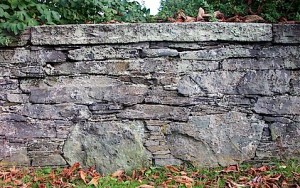
Why were stone walls built? The answer is for many reasons that have changed through the course of history. Speaking broadly about the regional phenomenon, the majority stone walls were built during the century between the American Revolution and the American Civil War in association with a widely distributed, and fairly uniform agricultural economy. Beginning in the mid 19th century, however, much of this rural land was abandoned, allowing forest to return. Near cities and centers of wealth, however, walls continued to be built, but for architectural, rather than agricultural reasons.
To understand the purpose of stone walls, we must discriminate between the word “purpose” which implies intent or volition, and the word “function” which describes what a wall does, whether intentionally or otherwise. Back then, the function of walls was purposeful.

THEN
Initial wall-building efforts served three purposes, all of which operated simultaneously. The principal purpose however, varied from wall to wall, farm to farm, and time to time.
-
DISPOSAL. Walls were built to hold the non-biodegradable agricultural refuse we refer to as stone or rock. After clearing the forest, they had to pick up and scuttle the stone away, usually to the nearest pile or fenceline. This was especially true for tillage fields and high-quality pastures. Piles, a temporary measure, were usually sledded or carted to edges.
- CONTROL. Much of the waste stone accumulating in piles and along fencelines was put to some expedient use having to do with private property. Most of it was used for subdividing property (boundary markers, field subdivisions, and livestock enclosure). Much of the remainder was used for the construction of foundations, the filling of wet land, the strengthening of embankments, and other engineered structures.
- EXPRESSION. Nearly all stonework reflects a personal/cultural artistic overlay, which involves conscious and subconscious patterning and style of the stone in the form of folk art.
Historically, the purpose of disposal usually preceded the purpose of control, which preceded the purpose of expression. Historically, walls were often built for one purpose, but served all functions simultaneously.

NOW
An abandoned wall no longer has a purpose. But it still has one or more functions, none of which were originally intended.
-
HABITAT refers to the function of the wall as a habitat, place to live on the stone, between the stones, or against the wall. It also subdivides the larger habitat by being a barrier or boundary controlling the movement and location of water, soil, plants and animals in the context of the woodland ecosystem. And for many animals, walls are corridors for movement.
-
MATERIAL RESOURCE refers to the function of the wall as a source of stone for other projects. The SWI discourages this practice under normal conditions, but cannot wish it away. The most common other project is to build a younger wall.
- CULTURAL RESOURCE refers to the function a wall plays as an archaeological artifact. Together, they create a shared landscape aesthetic, and convey a sense of regional geographic identity. Every stone wall is a work of folk art.
- HISTORY refers to the function of the wall as a discrete historical object, one that can be used to document or interpret history, especially at the local level.
